Tuesday, July 27th 2021

Intel Rebadges 10nm Enhanced SuperFin Node as "Intel 7," Invents Other Creative Node Names
Intel, in a move comparable to its competitors' Performance Rating system from the 1990s, has invented a new naming scheme for its in-house foundry nodes to claim technological parity with contemporaries such as TSMC and Samsung, that are well into the sub-10 nm class. Back in the i586 era, when Intel's competitors such as AMD and Cyrix, couldn't keep up with its clock-speeds yet found their chips to be somewhat competitive, they invented the PR (processor rating) system, with a logical number attempting to denote parity with an Intel processor's clock-speed. For example, a PR400 processor rating meant that the chip rivaled a Pentium II 400 MHz (which it mostly didn't). The last that the PR system made sense was with the final generation of single-core performance chips, Pentium 4 and Athlon XP, beyond which, the introduction of multi-core obfuscated the PR system. A Phenom X4 9600 processor didn't mean performance on par with a rival Intel chip running at an impossible 9.60 GHz.
Intel's new foundry naming system sees its 10 nm Enhanced SuperFin node re-badge as "Intel 7." The company currently builds 11th Gen Core "Tiger Lake" processors on the 10 nm SuperFin node, and is expected to build its upcoming 12th Gen Core "Alder Lake" chips on its refinement, the 10 nm Enhanced SuperFin, which will now be referred to as "Intel 7." The company is careful to avoid using the nanometer unit next to the number, instead signaling the consumer that the node somehow offers transistor density and power characteristics comparable to a 7 nm node. Intel 7 offers a 10-15 percent performance/Watt gain over 10 nm SuperFin, and is already in volume production, with a debut within 2021 with "Alder Lake."This is where things get interesting. The successor to Intel 7 is named Intel 4, and is technically a 7 nm EUV node. This node offers a 20 percent performance/Watt gain over Intel 7 (aka 10 nm Enhanced SuperFin), and will debut in mid-2022 with "Meteor Lake" client- and "Granite Rapids" enterprise processors. Intel has gone with "4" for the name as 2022 sees both Samsung and TSMC roll out their sub-5 nm nodes. TSMC will debut the 4 nm, while Samsung will hopefully iron out its 5 nm yield issues, and ramp up 4 nm, by 2022.Intel 3 succeeds Intel 4 in the second half of 2023, and is timed to launch around the time TSMC comes out with its sub-4 nm node, likely the 2 nm. Intel claims this node offers an 18 percent performance/Watt gain over the Intel 4, implement a denser HP library, increase the use of EUV, improve the drive-current and via resistance, to result in the performance/Watt target. With no mention of FET size, it's very likely that Intel 3 is still a 7 nm node.It's only in 2024 that Intel is promising major technological breakthroughs, with Intel 20A, heralding the era in silicon fabrication where transistor sizes are measured in Angstroms (0.1 nm). 20A would hence be a creative way of saying 2 nm. Intel will introduce a brand new transistor design it calls the RibbonFET. It remains to be seen if this is a whole new innovation or similar to nanosheet FETs. Intel is also announcing PowerVia, a revolutionary new way to connect silicon dies with each other, or with the package, which debuts with the Intel 20A node. The company is targeting a 1H-2024 debut of this new node.
With these, Intel is ensuring that it has a new node to offer each year leading up to 2024, each with a double-digit percent performance/Watt gain, so the company can restore something resembling its "Tick-Tock" product development cadence, enabling it to compete not just against AMD, but also the emergence of serious Arm-powered rivals, such as NVIDIA, Qualcomm, and Apple. The company is hence facing similar levels of competition as the early 1990s. x86 may no longer have a stranglehold over the PC, as Arm-powered rivals claw away at market-share with efficient and fairly-powerful chips.
The complete slide-deck follows.
Source:
VideoCardz
Intel's new foundry naming system sees its 10 nm Enhanced SuperFin node re-badge as "Intel 7." The company currently builds 11th Gen Core "Tiger Lake" processors on the 10 nm SuperFin node, and is expected to build its upcoming 12th Gen Core "Alder Lake" chips on its refinement, the 10 nm Enhanced SuperFin, which will now be referred to as "Intel 7." The company is careful to avoid using the nanometer unit next to the number, instead signaling the consumer that the node somehow offers transistor density and power characteristics comparable to a 7 nm node. Intel 7 offers a 10-15 percent performance/Watt gain over 10 nm SuperFin, and is already in volume production, with a debut within 2021 with "Alder Lake."This is where things get interesting. The successor to Intel 7 is named Intel 4, and is technically a 7 nm EUV node. This node offers a 20 percent performance/Watt gain over Intel 7 (aka 10 nm Enhanced SuperFin), and will debut in mid-2022 with "Meteor Lake" client- and "Granite Rapids" enterprise processors. Intel has gone with "4" for the name as 2022 sees both Samsung and TSMC roll out their sub-5 nm nodes. TSMC will debut the 4 nm, while Samsung will hopefully iron out its 5 nm yield issues, and ramp up 4 nm, by 2022.Intel 3 succeeds Intel 4 in the second half of 2023, and is timed to launch around the time TSMC comes out with its sub-4 nm node, likely the 2 nm. Intel claims this node offers an 18 percent performance/Watt gain over the Intel 4, implement a denser HP library, increase the use of EUV, improve the drive-current and via resistance, to result in the performance/Watt target. With no mention of FET size, it's very likely that Intel 3 is still a 7 nm node.It's only in 2024 that Intel is promising major technological breakthroughs, with Intel 20A, heralding the era in silicon fabrication where transistor sizes are measured in Angstroms (0.1 nm). 20A would hence be a creative way of saying 2 nm. Intel will introduce a brand new transistor design it calls the RibbonFET. It remains to be seen if this is a whole new innovation or similar to nanosheet FETs. Intel is also announcing PowerVia, a revolutionary new way to connect silicon dies with each other, or with the package, which debuts with the Intel 20A node. The company is targeting a 1H-2024 debut of this new node.
With these, Intel is ensuring that it has a new node to offer each year leading up to 2024, each with a double-digit percent performance/Watt gain, so the company can restore something resembling its "Tick-Tock" product development cadence, enabling it to compete not just against AMD, but also the emergence of serious Arm-powered rivals, such as NVIDIA, Qualcomm, and Apple. The company is hence facing similar levels of competition as the early 1990s. x86 may no longer have a stranglehold over the PC, as Arm-powered rivals claw away at market-share with efficient and fairly-powerful chips.
The complete slide-deck follows.
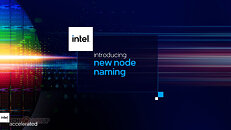

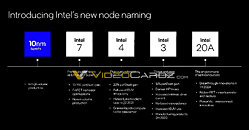

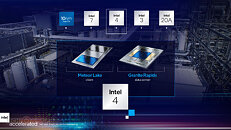



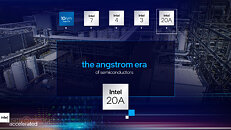

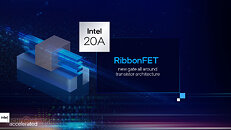
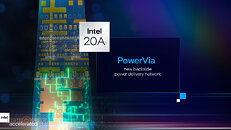







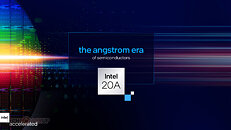

















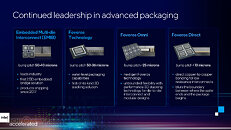





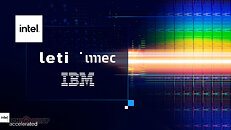








101 Comments on Intel Rebadges 10nm Enhanced SuperFin Node as "Intel 7," Invents Other Creative Node Names
How dare they :D
With all the bullshit in the piece, this should be at least marked as Editorial.
Performance Rating is wrong comparison, pure and simple.Which, by all indications, it does. Also probably comparable to TSMC/Samsung 7nm node evolutions that are called some variation of 6nm.It is technically an Intel 7nm EUV node, which is comparable to TSMC's and Samsung's 5nm node.
Also, reducing the number by a little or lately by one is common enough for TSMC and Samsung to denote advancements on existing node, basically the same as Intel's use of +. Fo example, TSMC already has a node called N4 (in the family of 5nm nodes).
Intel "10nm" - 100.76 MTr/mm2
Samsung "7nm" - 95.08 MTr/mm2
TSMC "7nm" - 91.2 MTr/mm2
TSMC has the smaller "nm" number and yet the worst density of all. Seems disingenuous if you ask me.
Just to make my point even stronger:
TSMC "10nm" - 52.51 MTr/mm2
Samsung "10nm" - 51.82 MTr/mm2
If anyone is trying to fool us is TSMC and Samsung. Intel should've aligned their naming scheme ages ago.
EDIT: Samsung 7nm
These numbers are probably from SRAM cells and the high density/low power variation of the node. Basically maximum possible number which does not necessarily mean any real usage in that range.
In High performance variations density suffers. A lot. GPUs are probably the easiest way to get real-ish numbers, for example RDNA2 GPUs are around 50-51 MTr/mm2. RDNA1 was 40-41 MTr/mm2 (both an older version of N7 and likely RDNA2 gains some density from huge cache).
Edit:
Also, your quote has Samsung's 7nm number.
Samsung 8nm is an older 10nm half-node evolution with claimed density of 61.18 MTr/mm2.
The Samsung 8nm variation used for Nvidia Ampere GPUs has in that application density of 44-45MTr/mm2.
2023 is more like it!
Something I would usually do via DMs might as well get typed here.
This was uploaded a single hour before NDA lifted on all of the actually important and interesting bits. Was this stuff not transferred to TPU? odd.
Dammmmn Intel ,the ball's on you people.:p :D
I expect the next one will be Super Secret Ultra Fin.
Now they went back to simple numbers.
How disgraceful
This is only for people that might want to buy manufacturing process. I am not surprised that they are renaming their manufacturing node when they want to start to produce chips from others company. But before that, who care.
they better bring atleast 30% improvment in performance and also efficiency. otherwise it dont matter what they call.
the nm will always be ringing bells on everyone'head if it doesnt and will keep blaming it till the end.
Nodes naming have been BS for years and if we are going to be mad about it then be mad at all foundries. I guess people are just too much in the Intel hate bandwagon.